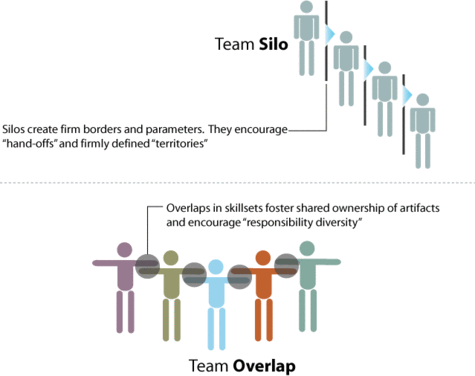When Everybody’s Responsibility Becomes Nobody’s Responsibility
Filed Under Human FactorsAwhile back I read a post about breaking silos of responsibility. These rigid territories of responsibility tend to increase the overhead of communication. In general, I agree with the mentality of fluid responsibility amongst agile self-organizing teams. However, the dangerous side of fluid teams must be explored before allowing a team ‘off the leash’.
Photo provided by Logic + Emotion
Even in the most disciplined teams, tasks belonging to ‘everyone’ actually belong to ‘no one’. In these situations it is commonly heard “I thought you were going to take care of that!” I call this an example of Hippie Socialism.
Hippie Socialism occurs when we sing songs around the campfire, speaking of a society based on even distributions of wealth and trade services. But what happens after the hippie love-fest campfire dies and ways are parted. Damn straight, it becomes a dog-eat-dog world again and the ideals are disregarded for tactics of survival.
Is this any different in a business environment? We have project kick-off meetings where we envision future success as a team. We promise everyone will share responsibilities and be a whistle blower as needed. In the end we tend to silo ourselves so that we may finish the responsibilities we were explicitly tasked. There is little or no time to work on the community tasks, or to help your neighbor. As a result, we are still left with communication overhead and unfinished tasks.
Perhaps I am taking the concept to a negative extreme, but exploring this allows a possible conclusion that some (even if thin) lines of authority must be drawn for progress to be made. As an example, I found a post scrutinizing a common management mantra, “Hire the best people, then get out of the way“. Paraphrasing his modified mantra:
Hire the best people, give them clear goals, give them the authority to achieve those goals, and then you get out of the way… – Stephen A. Bohlen
Managers with strong leadership skills but no domain knowledge tend to run responsibility silos so they may ‘black box’ or cover their weaknesses. Managers with strong knowledge but are weak leaders tend to run hippie communes. Without strong leaders to help find the sweet spot on agile teams just beware that agile self-organizing teams can be equally as dangerous as silo teams.
5 Responses to “When Everybody’s Responsibility Becomes Nobody’s Responsibility”




Good post!
I’ve definitely see this issue crop up on agile teams. It seems pretty common when teams first transition to an agile way of working.
Thankfully, in most cases it was temporary while team members get used to the extra responsibility that comes with self-organization. Once people learn to ask “who’s taking care of (shared responsibility x)?”, the confusion often clears up. It’s a good example of the agile principles of communication and rapid feedback. 🙂
[…] this over on {Codesqueeze}. He talks about the danger of self-organizing teams. When people […]
a commmon issue most nicely brought out… the hippie style can be observed in startups where the number of people involved is less or in small teams. and things work out fine, probably better than the rigid responsibility division.. but as the number of people increases, then usually because of communication problems some of the work will not be done at all or done by 2 or more people.. then begins the blame game :)..
I will never, ever, ever utilize “agile” or any for thereof. That stuff is so fruity that its not funny. I’d want to smack the first person who came to me and said “who is taking care of SHARED responsibility X?”
Going with this logic, why do we even need a corporate structure? A CEO, a Board of Directors, VPs and CIOs and accounts or secretaries… I mean, wasnt the secretary supposed to go out on that sales call in Duluth and wasnt the CEO supposed to order staples for the office?
Come on. There is a LOT to be said for structure and its those same people that cry “change is good” that the same types that dont adhere well to “staying the course” and certainly dont take too well to personal responsibility for the actions they took.
I.E. if you think I am going to fix your bugs, you’re crazy. I’d rather work alone then. =)
Excellent post. I think the best results are when a company can find the right balance between silo and group ownership. To much group mentality and you run into chaos, too much structure and the company slows to a halt.